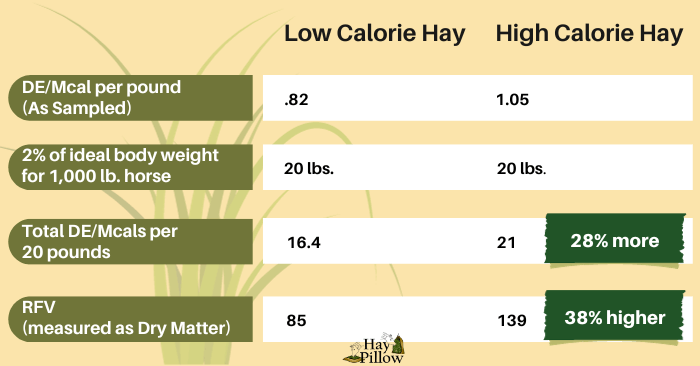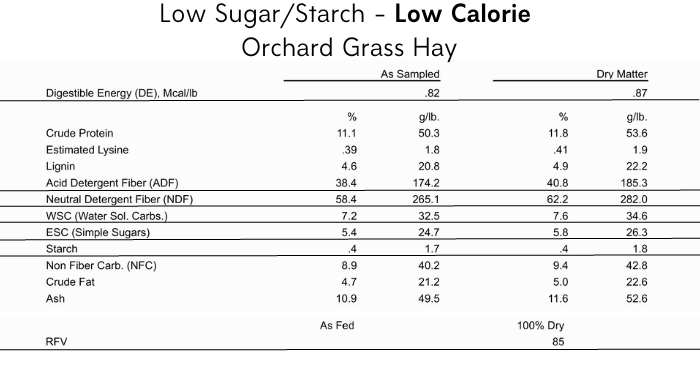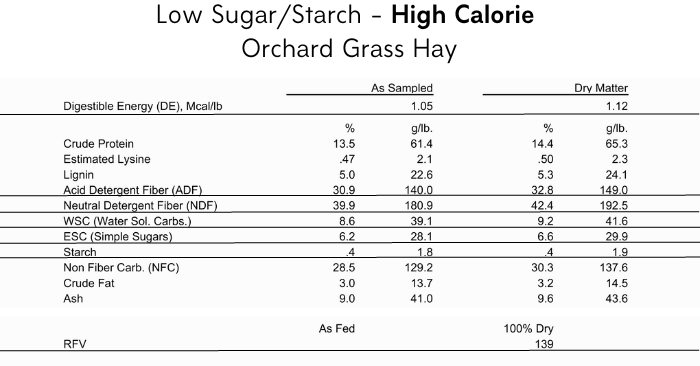Beyond Low Sugar/Starch - Choosing Hay for Weight Management
What if choosing the best hay for your insulin resistant (IR), metabolically challenged or overweight equine just got easier? What if that hay also allowed you to minimize or eliminate periods of fasting so that your horse could benefit from nibbling longer - without unwanted weight gain? Done and done!
Read on to learn more about relative feed value (RFV), a rarely considered nutritional factor, and Digestible Energy (DE) - and how you can confidently choose the most appropriate hay for your equine’s weight management goals.
Disrupting Conventional Approaches
The most common recommendation for feeding metabolically challenged equines and/or striving for weight loss is to provide a minimum of 1.5% of your horse's current body weight or 2% of ideal weight, (whichever is more) of grass hay with less than 10% NSCs (non-structural carbohydrates).
Unfortunately, this approach does not consider the important role of relative feed value (RFV), digestible energy (DE) or periods of fasting. Not all low-sugar-starch hays are created equal.
A New Formula - Looking Beyond Low Sugar/Starch
Choosing the most appropriate forage for your equines should be determined by metabolic status, current body condition score, energy and nutrient requirements, stage of life and activity level.
Ideally, if your equine needs to lose weight, implement slow-feeders and choose a hay with low NSCs, relative feed value, and digestible energy.
These factors allow you to confidently feed more than 1 1/2 - 2% of body weight – and feed more in line with natural behavior - to provide adequate bulk, satiation, and chew time while achieving favorable results.
Understanding RFV
According to Natalie Sullivan, accomplished equine nutritionist, and owner of On Course Equine Nutrition:
“The Relative Feed Value (RFV) is a number found on a hay or pasture analysis. It is an end result of forage species, environmental conditions, water and fertilizer, and when a forage grower harvested the product.... [It’s] one of the THE MOST IMPORTANT numbers related to feeding your horse, but the funny thing is that you've likely never heard of it.... RFV is a rough estimate of HOW the forage will behave in your horse; will it make your horse gain weight, lose weight, or stay the same?”
As an example, Sullivan offers this value breakdown for a 1,100 lb. horse with an average metabolism and in light to moderate work:
- Relative Feed Value > 100 = Weight Gain Hay
- Relative Feed Value Between 90-99 = Stay the Same Hay
- Relative Feed Value < 90 = Weight Loss
Please read Sullivan’s brilliant article it in its entirety to gain a better understanding of RFV’s importance and relevancy.
A Deeper Dive - Hay Tests Tell the Whole Story
Conventionally, NSCs tend to be the main focus when testing and buying hay. However, we learn much more by introducing relative feed values and digestible energy into the mix. Both are a big deal if you want to minimize or eliminate periods of fasting and avoid weight gain.
To better illustrate this concept, please refer to the two low sugar/starch orchard grass hay tests pictured below. Both are technically low in NSCs, but when we include the RFV and DE values in the analysis one hay becomes low sugar/starch + low calorie and the other becomes low sugar/starch + high calorie.
I have underlined digestible energy (DE), acid detergent fiber (ADF), neutral detergent fiber (NDF), WSC, ESC, starch, and relative feed value (RFV).
You can view the tests in their entirety by clicking on the photo, which will open the full test PDF file for viewing (mobile) or download (computer).
Surprise – 38% Difference in RFV & 28% Difference in Calories
Pictured below is a condensed comparison of the two low sugar/starch Orchard Grass hays using digestible energy & relative feed values.

Believe it or not, feeding 25.6 pounds of the low-calorie hay yields the same megacalories as 20 pounds of the high-calorie hay. Factor in the RFV value of 85 compared to 139 and you could offer more than 25.6 pounds of the low calorie hay comparatively.
Defining DE, ADF, NDF & RFV
Digestible Energy (DE) is the energy available to be digested and assimilated, assuming the individual has a healthy dental profile and digestive tract. Calories in equine diets are reported as megacalories (Mcal). One megacalorie equates to 1,000 calories. The test results reflect Mcal per pound.
Acid Detergent Fiber (ADF) is “a measure of cellulose and lignin. Cellulose varies in digestibility and is negatively influenced by the lignin content. As lignin content increases, digestibility of the cellulose decreases” (Source: Equi-Analytical). As values increase, digestibility of nutrients decreases.
Neutral Detergent Fiber (NDF) “is a measure of hemicellulose, cellulose and lignin representing the fibrous bulk of the forage. These three components are classified as cell wall or structural carbohydrates.” (Source: Equi-Analytical). As values increase, palatability decreases.
Relative Feed Value (RFV) is “an index for ranking forages based on digestibility and intake potential (palatability). RFV is calculated from ADF and NDF” (Source: Equi-Analytical). As values decrease, so does palatability and digestibility of structural carbohydrates.
Please refer to Equi-Analytical's Glossary of Nutrient Terms for further study.
Did You Know?
Feeding a less palatable hay naturally slows consumption rate. Aroma and texture are the main contributing factors to palatability. Course hay with no discernible aroma is far less appealing than a soft hay with a pleasing aroma. Surprisingly, sugar content (WSCs) does not influence the horses' preferences. See our post, Can Horses Eat More Hay Without Weight Gain? The Surprising Factors, which expands on this topic.
Meeting Nutritional Requirements
Whether your equine needs to lose, maintain, or gain weight to thrive mentally and physically, they require sufficient intake of healthy calories and optimum nutrient levels (water, fats, carbohydrates, protein, vitamins, and minerals).
No equine is immune to being malnourished, including overweight individuals. Optimum nutrition supports overall health, immune, hormonal, neurological and thyroid function.
Consult with an equine nutritionist to ensure all your equine’s nutritional needs are being met. It is important to note that low RFV hay tends to be more mature and lower in protein.
Our post, Healthy Gradual Weight Loss for Horses vs. Fasting & Forage Restriction, delves deeper into what a healthy diet should include and how periods of fasting worsen Insulin Resistance/Dysregulation.In Summary
Testing your hay is the only way to know the nutritional values of your forage - and it provides an array of results you can use for your horse’s, mule’s, and donkey’s weight management.
Focusing solely on sugar and starch (NSCs) levels reveals only a portion of the bigger picture to manage weight and metabolic status.
Including digestible energy (DE) and relative feed value (RFV) when choosing the most appropriate forage uncovers a simpler approach for meeting your equine’s individual physical and mental needs.
Helpful Resources
- Slow Feeding - Transition Tips & Techniques
- Healthy Gradual Weight Loss for Horses vs. Fasting & Forage Restriction
- 9 Benefits of Slow Feeding Horses - Get Slow Feed Savvy
- Horse Slow Feeder Safety Tips
- 7 Slow Feed Do's & Don'ts
- Choosing a Mesh Size for Slow Feeding
- How & Where to Test Your Horse's Hay & Interpret Results
References
- Sullivan, N. (2022, November 8) Relative Feed Value: The #1 Most User-Friendly Number for Feeding Horses. Retrieved from https://www.oncourseequinenutrition.com/post/relative-feed-value-the-1-most-user-friendly-number-for-feeding-horses
- Martinson, K. - University of Minnesota Extension (2021). Understanding your hay analysis. Retrieved from https://extension.umn.edu/horse-nutrition/understanding-your-hay-analysis#relative-feed-value-%28rfv%29-1320264
- Equi-Analytical. Glossary of Nutrient Terms. Retrieved from https://equi-analytical.com/resources/glossary-of-nutrient-terms/
- Batts, L. (2014, June 12) Digestible Energy in the Equine Diet. Retrieved from https://equinenutritionnerd.com/2014/06/12/digestible-energy-in-the-equine-diet/
- Smith, E. Understanding a Hay Analysis. Retrieved from https://www.platinumperformance.com/articles/hay-analysis.html
- Thunes, Clair. (2024, January 15). Free-Feeding Hay: When Will My Horse Slow Down? Retrieved from https://thehorse.com/17722/free-feeding-hay-when-will-my-horse-slow-down/





